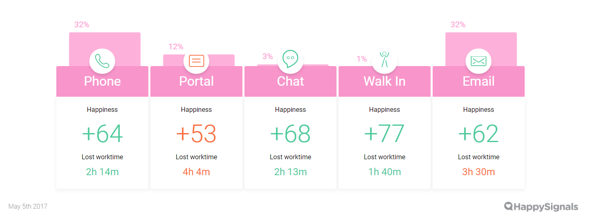Let’s talk about the employee experience metric. Our company HappySignals was founded on the realization that IT service management (ITSM) teams are still measuring service quality in process metrics by way of service level agreements (SLA). Essentially, this means that the ambition levels of service desks are at the lowest possible (acceptable) level, since they’re aiming to meet the SLA requirements. Then, at the same time, employees complain about the quality of IT support – it’s “the watermelon effect,” green on the outside (because targets are being met) but red on the inside (because employee expectations aren’t being met).
But things are changing
In 2016, we saw a significant increase in demand from enterprises looking for ways to measure employee happiness and productivity. As a result, in February 2017 we released our new cloud-based Employee Experience Management Suite, remodelled to make it as easy as possible for customers to focus on creating actionable, real-time reporting.

It was also evident how alone and isolated internal service management people have become compared to those working on customer experience, with them having readily-available external satisfaction benchmarks. We responded to this by creating HappySignals Benchmark which shows how service happiness and productivity is performing across large enterprises around the world. Today we have a rolling six-month benchmark of IT incidents from circa 100,000 employee feedback scores divided into service channels, countries, and employee profiles. Here’s a snapshot of channel success:
How does an employee experience metric differ from a traditional ITSM metric?
An employee experience metric:
- Measures end-to-end happiness. What happens prior to a ticket request is omitted when only measuring process times.
- Focuses on service performance. How employees feel about services is not solely the responsibility of the service desk. We are encouraging enterprises to measure service performance against lost productivity and to then jointly develop those services with providers, service owners, and service desk personnel.
- Provides business value for business stakeholders. If you want to increase your ITSM’s position in the value chain, then you need to give business stakeholders metrics they care about – which usually relate to money. The greatest differentiator for our employee experience metrics is that we don’t just measure satisfaction or happiness, but also lost work time for employees and the associated costs. This can be directly used in business case calculations.
- Feeds continual improvement (formerly CSI) information that sparks improvements. This could be to IT operations or the IT services they deliver.
- Feeds DevOps meaningful development requirements. DevOps cycles need input and what’s a more meaningful input than developing features that increase productivity and reduce the frustration directed toward your IT services?
How to Make It Happen
There are three key employee experience metric factors:
- Measurement needs to be continuous. I’ve heard this multiple times from employees – that there’s a conspiracy where employees are only asked for their opinion (about IT performance) when everything goes well. And when there’s a bad experience, they’re not asked for feedback. Employees need to be given the opportunity to score their experience at the moment the ticket is resolved.
- Get enough volume so you can believe the data. Traditional customer satisfaction response rates of less than 10% leave you guessing the validity of the data. Our customers typically have response rates exceeding 30%, with some well over 50%.
- Base your contract on employee experience. Write or rewrite internal, intra-business agreements or outsourcing contracts around your employee experience metric(s).
Learn more at my employee experience SITS17 session
This year at SITS17, the UK’s highest-attended ITSM conference, I’ll be presenting on how to make employee experience the most meaningful metric. During my session, I’ll present multiple customer cases on how HappySignals customers have done this, changing their internal discussions and increasing ITSM’s position in the value chain. Please attend to hear how:
- Cargotec, a global logistics equipment manufacturer, completely changed their internal discussion.
- Tieto, the largest Nordic IT company, listened to their employees and made significant positive changes to one of their most used ERP applications in just three weeks.
- Pöyry, an international consulting and engineering firm, rewrote their outsourcing contract around employee experience metrics for their front-office services.
Pasi Nikkanen
Pasi Nikkanen is the Chief Product Officer at HappySignals Ltd, who is passionate on changing how large enterprises measure and lead based on employee experience. Past positions include Head of Digital Channels at the largest Nordic IT company and Regional Manager EMEA in the field of Enterprise Social.

